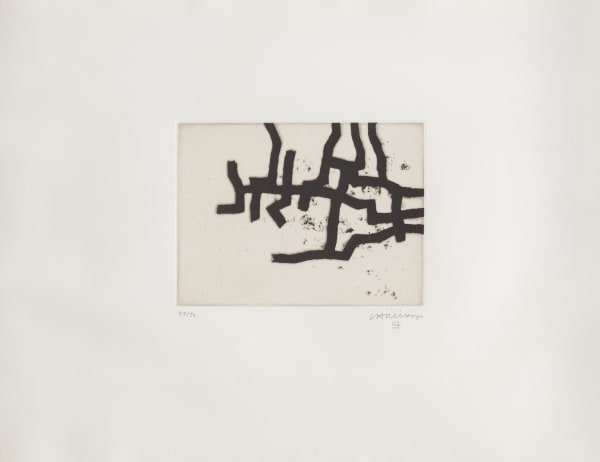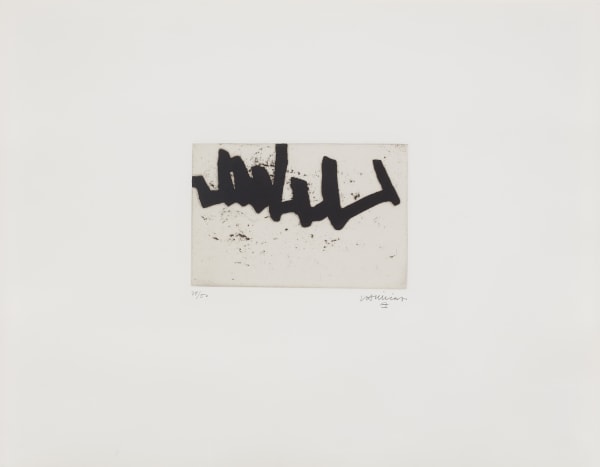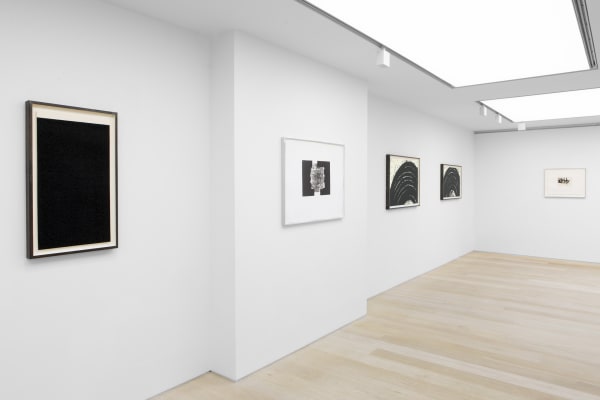Eduardo Chillida
Eduardo Chillida (1924 - 2002) was born in San Sebastián, Spain. He began his career in 1943 studying architecture at the University of Madrid, but in 1947 gave it up to draw and make sculpture. In 1948 Chillida was awarded a scholarship to attend the Cité Internationale Universitaire and travelled to Paris. He had his first solo exhibition at Galería Clan, Madrid in 1951.
Best known for his monumental sculptures in iron and stone, Chillida also produced a distinguished body of etchings, lithographs and woodcuts, which as well as retaining something of the physical, weighty quality of his sculptures, allowed him to explore form and line. Chillida's monumental sculptures designed for both urban and more reclusive spaces are permanently installed internationally.
Recent solo and monographic exhibitions include The San Diego Museum of Art, San Diego (2025); Instituto Cervantes de Roma, Rome (2024); Krems Kunsthalle, Austria (2023); Museo Chillida-Leku, Hernani (2021, 2019); Meadows Museum, Dallas; Les Abattoirs, Toulouse; Museum Wiesbaden, Hesse; Rijksmuseum, Amsterdam (2018).
2024 marked the centenary of the artist's birth. This event was commemorated with exhibitions and projects across museums and institutes in Spain including Chillida Leku; Artium Museum; Museo Nacional de Escultura; Cristóbal Balenciaga Museum; and Guggenheim Museum Bilbao. Further exhibitions were staged in the USA, Chile, Germany and Austria.
Major retrospectives of Chillida's graphic and sculptural work, staged during his lifetime, were mounted by Museo Nacional Centro de Arte Reina Sofía, Madrid (1999); Institut Valencià d'Art Modern (1998); Palacio de Miramar, San Sebastián (1992); Solomon R. Guggenheim Museum (1980); National Gallery of Art, Washington, D.C. (1979); Carnegie Institute, Pittsburgh (1979); Staatliche Kunsthalle Baden-Baden (1978); and Museum of Fine Arts, Houston (1966).
Chillida took part in Documenta in 1959 and 1968. He represented Spain at the 1958 Venice Biennale, winning the Grand International Sculpture Prize. Numerous awards include the Kandinsky Prize (1960); Carnegie Prize for Sculpture (1964); Andrew Mellon Prize shared with Willem de Kooning (1978); Medalla de Oro al Mérito en las Bellas Artes from the Spanish Ministry of Culture (1981); Grand Prix National des Beaux-Arts from the French government. (1984); Jack Goldhill Award from the Royal Academy of Arts in London (1996); and the Lifetime Achievement Award from the International Sculpture Center in Washington, D.C. (1997).
In 2000 Chillida opened Chillida Leku, an exhibition space and sculpture park converted from a farmhouse in the town of Hernani, near San Sebastián. The space is also now home to The Fundación Eduardo Chillida y Pilar Belzunce, a non-profit organisation that studies and promotes the work of Chillida.
Eduardo Chillida died aged 78 in 2002 in San Sebastián, Spain.
Selected works
Installations
News




















